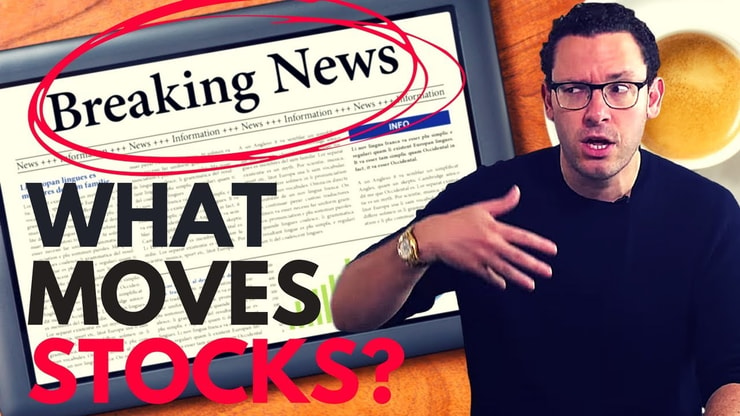What has the power to move stock prices faster than a speeding bullet? Stock catalysts!
A stock catalyst is any information that can influence a stock’s price. It can pertain directly to the company, the industry, or the world at large.
Wait … there are tons of developments or bits of news that can potentially act as a catalyst. So how can you tell which ones might have the power to move a stock?
I’ll help you answer that exact question. Today I’ll give you an introduction to stock catalysts, including specific examples. And I’ll give you tips on how to identify strong catalysts and how to pair them with patterns … Let’s go!
Table of Contents
- 1 What Are Stock Catalysts?
- 2 Why Catalysts Matter to Traders & Investors
- 3 Hard Catalyst vs. Soft Catalyst
- 4 Must-Know Catalysts That Can Move Share Prices
- 5 Benefits of Stock Catalysts
- 6 Examples of Historic Stock Catalysts
- 7 What Are the Best Penny Stock Catalysts?
- 8 How to Identify Stock Catalysts
- 9 Key Tips While Dealing With Stock Catalysts
- 10 The Bottom Line
What Are Stock Catalysts?

A stock catalyst (also called a news catalyst or just catalyst) is anything that has the potential to move a stock’s price. Pretty broad, right? Let’s get specific.
Often, a catalyst is news related to a company. But sometimes catalysts can be indirect, like government regulations that can affect an entire industry. We’ll dive into lots of examples in a bit.
Why Catalysts Matter to Traders & Investors
I always teach my students to find the strategies that work for them. My millionaire students Tim Gritanni and Michael Goode have their own trading styles. That’s because they’re self-sufficient traders who’ve worked hard to find consistency in the markets.
So how do catalysts fit into trading strategies?
Different catalysts work with different setups. It takes time to learn that and how to react to different catalysts. It’s why you have to study.
You can start with my 6,300+ video lessons by subscribing to Pennystocking Silver. Looking for a FREE resource? Access my penny stock guide here.
You gotta find the style that works for you and stick with it. Catalysts are only part of the larger picture.
To better understand all that goes into a trade, read “The Complete Penny Stocking Course.” My student Jamil created it to summarize my teachings — from understanding catalysts to building watchlists. Get your copy and start learning the rules I follow to trade penny stocks.
Hard Catalyst vs. Soft Catalyst
Not all catalysts are equal. There are two main groups — hard (direct) and soft (indirect).
Hard catalysts refer to something directly related to the stock. That can be an earnings report, a new contract, or a press release. It’s anything with a direct relationship to one specific company.
Soft catalyst refers to an indirect relationship. New government regulations or global events fall into this category. Don’t worry … we’ll cover plenty of examples.
Not every catalyst can move a stock. You gotta look at the bigger picture. Check out this video where I break it down…
Traders need reasons to buy and sell stocks. Catalysts are that reason. They can provide a story for people to fall in love with. Here’s a comprehensive list of the most common catalysts…
World Events
Right now, we’re in the midst of the coronavirus pandemic. Companies that produce masks, potential vaccines, or faster tests have seen massive movement. These stock prices moved 100%, 200%, or more.
Major events like this create hot sectors. In the past, news events like Ebola, weed legalization, and even police body cameras have driven related stocks to make huge moves.
Company News
Sometimes, the news that rocks a stock price is specific to one company rather than the entire sector. A good example here is a tech company like Apple Inc (NASDAQ: AAPL). In this case, you’re looking for anything significant. Think major product launch or an announcement of an updated iPhone.
More Breaking News
- Top Bitcoin Stocks to Watch Under “Crypto Emperor Trump”
- BigBear.ai’s Journey in the Stock Market: Rising Trends and Challenges
Earnings Winners and Losers
Publicly traded companies must report earnings every quarter. Any time you see a stock on the move, check its earnings report release date. If the report is only a day or two old, it’s likely driving the price action.
Good earnings and bad earning can drive big price moves. But never try to predict if earnings will be good or bad. Instead, let the market decide the direction and react to the price action.
New Deals
Did a company sign a big new contract or forge a partnership with an industry leader? New business connections can generate new trends in stock prices. For example, when music-streaming service Pandora announced partnerships with AT&T and Snapchat, the stock price spiked nearly 20%.
Hires and Fires
Is a company experiencing changes in management? Time and time again, changes to the executive management team prove to be catalysts. Just search online for “CEO steps down, stock plummets” … You’ll see countless results where the stock price plummeted after a CEO resigned or is fired — especially when the company is suffering.
Regulation, New or Repeal
Whenever the government makes a major policy change, this can be a catalyst for business in a related sector. After multiple police shootings, several cities changed the way they police. New laws mandating police body cams caused several security-related stocks to spike.
And ending prohibition on weed in states across the U.S. gave many weed-related stocks a boost.
News Articles
When a company’s featured in the media — in a positive or negative light — it can drive a large price swing. News articles can potentially reach millions of people. And if those people are traders, there’s the potential to spike a stock. Especially when you add short-sellers and momentum traders to the mix.
Analyst Upgrades and Downgrades
I teach my students to not follow ‘hot’ trading tips or stock picks from anyone.
Analysts at large institutions make ‘buy’ and ‘sell’ picks all the time. But they’re often wrong, so take ratings with a grain of salt. Can an upgrade or downgrade move stocks? Sure. But not always. Do your research.
Mistaken Identity
The key thing to remember with this catalyst is that a lot of people are idiots. Enough so that they can inadvertently move stocks — all because they do zero research.
One example is Zoom Video Communications, Inc. (NASDAQ: ZM). Note the ticker is ZM and the company is named Zoom. But when ZM had news, the completely unrelated Zoom Technologies with the ticker ZOOM would move too (it was even halted at one point).
Smart traders do research — just like you are right now.
Billionaire Plays
Word that a billionaire or a big-time hedge fund manager invests in a company can move the stock. People like to know that they’re following the big money. Just be VERY cautious with this catalyst — sometimes the billionaire will sell into a big spike.
Biotechs
Biotech companies often announce results of clinical trials or FDA approvals that can cause huge moves. Never try to predict these moves ahead of time. You can blow up your account if you’re wrong. Instead, be aware of the news. Look for setups with good risk/reward potential.
Benefits of Stock Catalysts

Catalysts provide reasons for people to buy or sell a stock. Take the catalyst into account along with the whole story of the stock. What does the pattern look like? What time of day is it?
The benefits of understanding catalysts are huge. Here are the biggest benefits:
- The best opportunities: A catalyst brings new traders to the stock. This surge in interest usually leads to a surge in volume. If enough volume comes in, it can cause a breakout. I don’t trade stocks that are stuck mid-range. Breakouts and breakdowns can offer better trading opportunities.
- Predictable patterns. A good catalyst can cause a surge of volume and a major short squeeze on low-float stocks. It’s not a 100% reliable strategy but it does repeat. I often say I’m a glorified history teacher … The sectors and companies change, but the patterns stay the same.
- Spot trends early. One of the biggest benefits of catalysts is that you possibly catch a move early. Knowing which catalyst to watch for can help you catch that price action.
- Strategy building. As my Trading Challenge students know, I rely most heavily on catalysts when choosing my trades. However, stock charts and technical analysis help me decide whether to trade and when. That said, never make a trade decision solely based on a catalyst.
Examples of Historic Stock Catalysts
To help you better understand the concepts in this post, here are real-world examples of past catalysts and how they moved stock prices:
#1 Marijuana Legalization in Canada
When Canada legalized pot, it put many a stock’s price one toke over the line.
In 2018, Canada legalized marijuana nationwide in a game-changing moment for the industry.
Companies dealing with the growth, distribution, and sale of marijuana were no longer in a legal grey area. Restrictions were lifted. These companies instantly gained a much larger audience for their products.
Finances for pot stocks were tricky before the legalization — now these companies could accept credit cards and take out bank loans.
What was a fringe industry was poised to boom into a multi-billion dollar industry. Stocks began shifting before legalization was official.
Following the legalization, many stocks experienced insane growth. For example, Aurora Cannabis Inc. (NYSE: ACB) traded at around $5 per share in August 2018. It quickly rose to over $12 per share in anticipation of and directly following the official announcement of legalization.
#2 Starbucks CEO Steps Down
When Howard Schultz left Starbucks, the stock price went down faster than you can say “Frappuccino.”
Howard Schultz actually had two separate stints as CEO. According to MarketWatch, after his first resignation in 2000, shares fell as much as 28% in the seven weeks following.
When Schultz bowed out in 2017, the decline in stock price was more incremental. First, he resigned as CEO and took the position of chairman of the board. This sent the stock price lower, but not massively.
When he stepped away from the company entirely, the news had its biggest impact, with shares declining sharply. The stock eventually rebounded, but it’s a great example of how a notable departure can move prices especially in the short term.
#3 Tesla CEO Smokes Pot
Puff, puff … pass? Elon Musk, the CEO of Tesla Inc. (NASDAQ: TSLA), was captured on camera smoking weed during a Joe Rogan interview. This on-camera blaze scorched share price.
Of course, there’s more to the story. This was just the straw that broke the camel’s back after a series of missteps on Musk’s part. That includes an unfortunate tweet about taking the company private, as well as a wave of resignations from the executive team.
Amid gossip about Musk’s potential drug problems and general pessimism about the company’s future, shares tanked from $375 highs down to $180 … more than 50%.
#4 Passage of the Farm Bill
Many traders saw the 2018 Farm Bill’s passage as the start of a CBD stock frenzy.
In late 2018, a news event rocked the world of weed stocks: The U.S. passed the Farm Bill, legalizing industrial hemp, a common source for CBD.
CB-what? CBD, or cannabidiol, is derived from the marijuana plant. But unlike THC (the psychoactive, get-high compound), CBD is non-psychoactive. It’s touted as a wonder cure, but because of its connection to marijuana, it’s mostly resided in a legal grey zone with a limited audience.
Once the bill passed, money poured into the CBD sector. Stock prices soared as the related companies put out press releases and signed new contracts.
#5 NIO Limited on “60 Minutes Overtime”
NIO Limited (NYSE: NIO) is an electric car manufacturer based in China. Since its IPO in October 2018, the stock price struggled to make significant gains.
Many people expected it to rival TSLA, but it lacked a strong catalyst. In February 2019, that catalyst finally came. “60 Minutes Overtime” featured it in a very positive light, portraying it as part of the emerging Chinese middle class.
The stock price surged from $8 to over $10 in just two days.
This is a great lesson on how quickly a stock can surge. It’s also a great lesson in how far a stock can fall after the hype is over. NIO has traded as low as $1.20 since the article and hasn’t recaptured its $8 level from before the feature.
#6 Mistaken Identity: The Herzfeld Caribbean Basin Fund Inc. (NASDAQ: CUBA)
In December 2014, President Obama moved to warm relationships with Cuba — the country.
There’s also a Miami-based company that invests in countries throughout the Caribbean. Its ticker? CUBA. The ticker’s where the company’s relationship to the country of Cuba ends. At the time, the fund had no investments in Cuba. It didn’t stand to benefit from the thawed relationship.
When the White House released news that the country of Cuba would be open to U.S. investment and tourism, the stock price soared. In just four days, it went from $7 to $15.
Remember to do your research.
#7 Combination: Multiple Catalysts
Blue Apron Holdings, Inc. (NYSE: APRN) is a food-delivery service that provides ingredients and recipes to customers. Ultimately, it’s a terrible company that loses lots of money, so traders like to short it.
Since January 2020, as the coronavirus spreads across the globe, APRN is doing surprisingly well. As cases began multiplying in the U.S., store shelves were sparse, and restaurants began closing under government orders.
Let’s look at all the catalysts involved here … First, there’s the pandemic, which is global news. Then there’s the lack of available food at grocery stores that many people experienced personally. Then came government regulation as cities and states told residents to shelter in place.
And people still need to eat, right? Enter APRN’s food delivery. Remember, this is a heavily shorted stock that no one believed in the day before. It’s also a low float … It doesn’t need many buyers to squeeze the shorts.
The combination of multiple catalysts and share structure created a full supernova. The stock went from $2 to $29 in just four days.
What Are the Best Penny Stock Catalysts?
The best catalysts are combinations like APRN. Think a low float with sudden new interest in the middle of a major world event.
Right now, the COVID-19 pandemic is a major world event. You hear about the need for testing, masks, and a vaccine. These are soft catalysts.
A combination occurs when there’s a secondary catalyst, like a new contract or positive clinical trial for a vaccine. These examples are hard catalysts.
Again, a catalyst is only a part of the overall picture. Use it to build a case to trade a stock.
Check out the indicators I use in my Sykes Sliding Scale. You can learn how to use this tool to help plan trades by studying my “Trader Checklist Part Deux” guide. Also, I use this stock scanning software every day. I trade with these rules and these are my brokers right now.
How to Identify Stock Catalysts
You can scan social media. Twitter especially has tons of up-to-the-minute info. There are hundreds of different news sites with analyst ratings, earnings reports, and press releases.
You can gather this info on your own or pay a service to do it for you. But the easiest, by far, is using StocksToTrade. It provides everything I listed above along with charts, fundamental data like the float and outstanding shares, and a platform to trade from. It’s literally a one-stop shop.
Key Tips While Dealing With Stock Catalysts
Knowing the catalysts is the first step. Identifying them is next. Fitting them into the overall picture is the most critical step. And always be prepared to cut losses quickly if a trade goes south.
Use a Stock Screener
Back in the day, I had over 100 news subscriptions to watch for hot catalysts. That’s no longer necessary. Now traders can use a stock screener.
StocksToTrade is my favorite stock screener and trading platform.
Full disclosure: I helped design it and some of its built-in scans. It’s perfect for penny stocks. I use it to search for big percentage gainers or stocks making new daily highs. It’s how you can find patterns that fit your trading plan. Here’s a quick preview:
Trade Only High-Volume Stocks
Let’s say you find an amazing catalyst (or series of catalysts)…
A company in a trending sector hires a hot new CEO — and it announces the cure for the common cold. Seems like this stock can only go up … right?
Not so fast. There’s never a ‘sure thing’ in the stock market. You still gotta do your research and look at the stock from multiple angles.
One important consideration is the volume or number of shares traded. As a general rule, I like to see at least a couple hundred thousand shares traded on the day. I never trade more than 1% of the daily volume.
No matter how amazing the catalyst might be, if the volume is low, stay away!
Now, if we’re talking about volume, we have to also talk about volatility. Volatility is a measure of how quickly a stock’s price moves up or down. The faster it moves, the higher the volatility.
That’s why it’s important to always have an exit plan. Any trade can go against you, especially high-volume stocks.
I just made a no-cost two-hour guide to help you learn how to trade through crazy volatility, like we’re seeing in the coronavirus pandemic and market crash…
Access the FREE “Volatility Survival Guide” Here
Catalysts in Context
The time of day and chart pattern are just as important as the catalyst. Don’t trade a stock based solely on a strong catalyst. A catalyst alone is not enough to get me to trade.
Timing your trades is another topic. Check out this post for more about timing.
You also gotta study chart patterns. They repeat over and over. Know which patterns look for and only trade the best setups. A random entry on a strong catalyst is a recipe for losing money.
I like to find a stock with a strong catalyst, wait for the right time of day, and then only if the right pattern shows up. And I trade like a retired trader … It takes the best setups for me come out of retirement. I suggest you approach trading the same.
Seek More Knowledge in My Trading Challenge
If you want to be smarter about catalysts, you need an intelligent approach to trading in general.
I started my Trading Challenge as a specific and targeted way for traders to get an education in the market that just wasn’t available when I started trading.
When I was learning to trade, I didn’t have a mentor. So I had to learn things the hard way. I designed my Trading Challenge to be that resource for other traders. And my ultimate goal is to teach you how to be a self-sufficient trader.
In the Trading Challenge, you’ll gain access to a massive DVD library, live trading sessions, lessons, and webinars with some of my top students. You can also be a part of what I think is the best trading chat room.
This is an opportunity to join a great community that can help speed up your learning curve. But you gotta be dedicated. Ready to learn? Apply now for my Trading Challenge now!
The Bottom Line
Catalysts can have a powerful and FAST effect on stocks. They can make stock prices surge or plummet in extremely short periods of time.
But this is only one piece of the puzzle. In my must-watch “Trader Checklist,” you can learn all seven key trade indicators. (Hint: if you have a Profit.ly account, you can watch the original “Trader Checklist” guide here.) A catalyst is only one of the seven indicators. Remember: look at the big picture.
Educate yourself on common catalysts and their effects. You’ll be better poised to face them in the future. They can help support your case for a trade or signal you to walk away.
What’s your experience in trading catalysts? Leave a comment and share your successes, your failures — I want to hear all of it!








Leave a reply